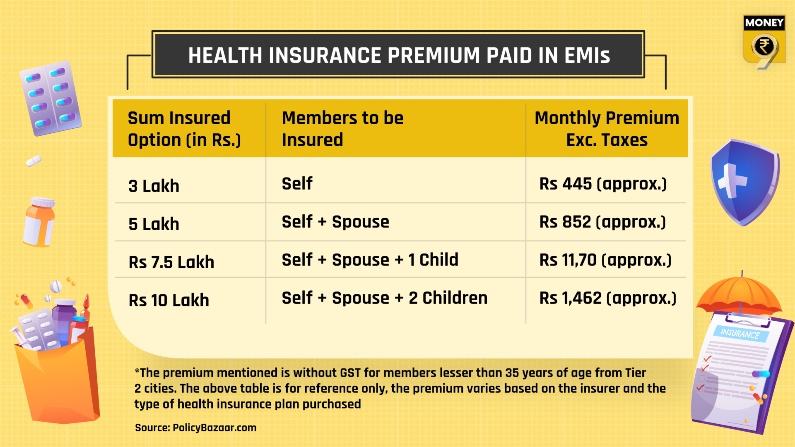Should you buy health insurance on EMI?
Section 80D of the Indian Income Tax Act allows you to claim a tax deduction for up to Rs 50,000 in premiums paid as EMIs on your Mediclaim policy
- Noopur Praveen
- Last Updated : August 24, 2021, 17:36 IST

Over the last year, the world around us has changed upside down. Nobody imagined the Covid-19 pandemic to become a global pandemic of such a scale that its impact would be felt even outside the realm of health. The pandemic was followed by an intense lockdown in various parts of the world including India. It destroyed lives, jobs, global economies and personal wealth all at once. But even when the human lifestyle is experiencing an abnormal shift, the need to secure one’s health must be prioritised at all costs.
With rising inflation in medical costs, the most efficient way to secure the health of loved ones and yourself is by investing in an adequate health insurance policy. This, as we have known, can provide financial relief during medical emergencies.
Health Insurance on EMI
However, we do realise that Covid-19 infection has caused massive job losses and significant pay cuts across sectors. What followed was a severe financial constrain in many families. This may make it difficult for many to pay insurance premiums. But, the availability of equated monthly instalments (EMIs) has somehow eased the situation for those who really need an insurance pack up but are forced to buy a low coverage plan in the wake of low premiums. With health insurance EMIs, you can now pay premiums in instalments instead of an annual lump sum.
“The purpose of introducing EMI for health insurance policies is to reduce the financial burden of customers in making the premium payment in one go. Customers can now pay the premium either on a monthly, quarterly, or half-yearly basis, depending on the facility provided by their insurance company. This makes insurance more affordable and thus accessible to all income groups,” said Gurdeep Singh Batra, head – retail underwriting at Bajaj Allianz General Insurance.
Cost-effective for policyholders?
A 10-day stay in a super-speciality hospital in a metro city like New Delhi or Mumbai can easily cost as much as Rs 5-7 lakh per person in today’s scenario. This has forced people to review their health insurance needs and paying strategies. With rising medical inflation, one is bound to move towards a higher sum insured policy. This can become feasible with the availability of the EMI option.

Hence, you are no longer require to compromise on quality health treatment as the benefits can be availed by paying the premium in mini instalments. For example, Rs 10 lakh insurance for a 35-year-old individual (including spouse and two children) from a tier-2 city will approximately cost Rs 1,462 per month as seen from the above table.
Moreover, Section 80D of the Indian Income Tax Act, 1961 allows policyholders to claim a tax deduction for up to Rs 50,000 in premiums paid as EMIs on your mediclaim policy.
Beneficial for senior citizens
Senior citizens are more vulnerable to health risks and the rising medical expenses only add to the financial woes. Thus, a standalone health insurance policy for older people is a must to tackle medical emergencies efficiently. Many senior citizens may not be able to afford a wide coverage policy as the age factor increases the premium cost. Hence, EMI is an attractive option for those with limited monthly income.
“Senior citizens are that section of our society who are more vulnerable to health issues and need to continue with their appropriate comprehensive health coverage. Paying health insurance premiums hence has become more affordable for them, as they can opt to pay the premium in installments and ensure continuity of their health insurance coverage,” Batra asserted.
How to pay insurance EMIs?
Customers can pay their health insurance premium either on a monthly, quarterly, or half-yearly basis, depending on the facility provided by their insurance company. If your insurance company provides an online payment option, then Batra suggests, “Customers can simply choose to pay the EMI online. They can also provide auto-debit mandate to the insurer, further to which the premium can also be auto-debited from the customer’s account to ensure continuity of policy and regular online payment of premium.”
While the basic premium cost won’t change whether you choose a monthly, quarterly or half-yearly premium payment option, in some cases the insurer may levy a slightly higher premium on EMIs basis the kind of health plan.
“A 12-time monthly EMI will be always costlier than the annual premium. Insurance companies invest the premium revenue to earn additional income,” pointed SK Sethi, founder at Ria Insurance Brokers.
Now if you pay the premium on a monthly basis and need to file a claim within the first six months of paying the premium, will the insurer process your claim? Yes, it will, however, the insurance company can deduct the remaining instalments or you may have to pay the pending amount to avail of the claim benefits. The overall claim procedure remains the same.
Should you opt for EMI?
It can be wise to buy insurance on EMI as it will ease the whole process and make it less burdensome for you as a whole. It won’t come in the way of your regular expenses in an intimidating manner as it would in case of lump sum payment.
In addition, you don’t have much reason to compromise or settle for a low coverage insurance plan just because of high premiums. Not only will this move help make insurance products more affordable but it will also help in furthering insurance penetration across the country.
Meanwhile, it’s important to note that you can change the mode of premium payment only at the time of policy renewal and not during the interim period. In case you’ve made up your mind to modify the payment method, you’ll have to either wait till the time of renewal or buy a new policy.
Download Money9 App for the latest updates on Personal Finance.
Related
- अब महज 15 दिनों में होगा डेथ क्लेम सेटलमेंट, IRDAI ने बीमा कंपनियों को दिए सख्त निर्देश
- Health insurance vs. Medical corpus: What’s your choice?
- Can Homebuyers Expect Tax Rebate from Budget’24?
- Budget 2024: Insurers anticipate tax reforms in health insurance
- Claim rejected even after completing Moratorium Period?
- Be Monsoon Ready with Home Insurance Damage Cover

